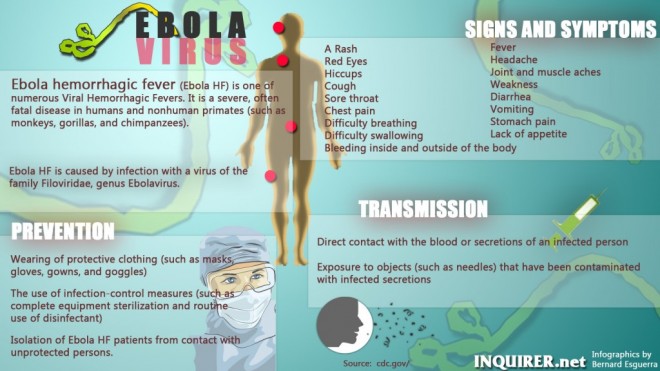PH adopting US testing, disease control methods on Ebola
MANILA, Philippines — The Philippines has firmed up its defenses against the deadly Ebola virus, adopting the latest testing and infection control protocol from the United States’ Centers for Disease Control and Prevention (CDC).
Tests would be done at the Research Center for Tropical Medicine (RITM) in Muntinlupa City, the “national referral center for emerging and reemerging infectious diseases,” Communications Secretary Herminio Coloma said on Sunday.
“The Philippines remains Ebola-free,” Coloma said on Radyo ng Bayan, citing the 18 suspected Ebola cases tested at the RITM which all yielded negative results.
“The Department of Health is doing everything to firm up our defense against the Ebola virus and other infectious diseases.”
Coloma said the DOH had laid out and was “still strengthening a multisectoral response plan” to prevent the entry into the country of the Ebola hemorrhagic fever, which has killed more than 4,000 people in seven countries.
The plan includes “interim guidelines for disease surveillance, notification and reporting of suspected” Ebola cases; “clinical management including laboratory testing of specimens; and “infection control.”
Based on its “interim guidance,” the US CDC said the Ebola viruses “are transmitted through direct contact with blood or body fluids/substances (urine, feces, vomit) of an infected person with symptoms or through exposure to objects (such as needles) that have been contaminated with infected blood or body fluids.”
The CDC recommends that Ebola patients be kept in a single hospital room with its own bathroom and with the doors closed. There should also be a log of all persons going in and out of the room.
These people should wear at least “gloves, gown (fluid resistant or impermeable), eye protection (goggles or face shield) and face mask.” Other requirements include “double gloving, disposable shoe covers and leg coverings.”
The CDC also advises people returning to the United States from countries with Ebola to “pay attention to your health” by doing the following:
* Monitor your health for 21 days if you were in an area with an Ebola outbreak, especially if you were in contact with blood or body fluids, items that have come in contact with blood or body fluids, animals or raw meat or hospitals where Ebola patients are being treated or participated in burial rituals.
* Seek medical care immediately if you develop fever (temperature of 101.5°F/ 38.6°C) and any of the following symptoms: Headache, muscle pain, diarrhea, vomiting, stomach pain, or unexplained bruising or bleeding.
* Tell your doctor about your recent travel and your symptoms before you go to the office or emergency room. Advance notice will help your doctor care for you and protect other people who may be in the office.
The DOH is also studying the need for more sophisticated machines at all international ports of entry to prevent potential carriers of highly infectious diseases like Ebola and the Middle East Respiratory Syndrome Coronavirus (MERS-CoV) from entering the country.
Health Secretary Enrique Ona admitted the thermal scanners installed at the international airports were not 100-percent reliable in screening the hundreds of thousands of travelers arriving in the country and could miss potential carriers of contagious diseases.
“There are major areas of gaps, where indeed there is a possibility that a passenger with exposure to Ebola can enter without being detected,” Ona said in a press briefing during the National Ebola Virus Disease Summit on Friday.
“There are a lot of people arriving at the airports so there is really a chance to miss passengers with symptoms,” he added.
Thermal scanners are devices that can detect high body temperatures as an indication of infectious disease. Fever is one of the symptoms of MERS-Cov and Ebola.
So far, the Philippines remains free of the two viruses. The country had a close call with MERS-CoV after a Filipino male nurse returned to the country in April from the United Arab Emirates, where he was initially diagnosed with the disease.
Confirmatory tests conducted by the RITM, however, yielded negative results. Health authorities surmised that he might have overcome the virus. None of the nurse’s co-passengers developed symptoms of the disease.
The Ebola virus has claimed more than 3,000 lives as cases of the disease continued to multiply in Sierra Leone, Guinea and Liberia. Cases of the virus have also been reported in Spain and the United States.
Health authorities during the summit emphasized the Philippines must be prepared to handle Ebola cases and should assume that it would reach its shores in a matter of time.
“I’d like these tested, the capacity and sophistication of our thermal scanners,” Ona told reporters, assuring the public that the government has been doing everything to avoid the entry of the deadly virus.
RELATED STORIES
Spain euthanizes pet dog of Ebola-infected woman
